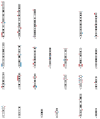Rare CNVs and Known Genes Linked to Macrocephaly: Review of Genomic Loci and Promising Candidate Genes
- PMID: 36553552
- PMCID: PMC9778424
- DOI: 10.3390/genes13122285
Rare CNVs and Known Genes Linked to Macrocephaly: Review of Genomic Loci and Promising Candidate Genes
Abstract
Macrocephaly frequently occurs in single-gene disorders affecting the PI3K-AKT-MTOR pathway; however, epigenetic mutations, mosaicism, and copy number variations (CNVs) are emerging relevant causative factors, revealing a higher genetic heterogeneity than previously expected. The aim of this study was to investigate the role of rare CNVs in patients with macrocephaly and review genomic loci and known genes. We retrieved from the DECIPHER database de novo <500 kb CNVs reported on patients with macrocephaly; in four cases, a candidate gene for macrocephaly could be pinpointed: a known microcephaly gene-TRAPPC9, and three genes based on their functional roles-RALGAPB, RBMS3, and ZDHHC14. From the literature review, 28 pathogenic CNV genomic loci and over 300 known genes linked to macrocephaly were gathered. Among the genomic regions, 17 CNV loci (~61%) exhibited mirror phenotypes, that is, deletions and duplications having opposite effects on head size. Identifying structural variants affecting head size can be a preeminent source of information about pathways underlying brain development. In this study, we reviewed these genes and recurrent CNV loci associated with macrocephaly, as well as suggested novel potential candidate genes deserving further studies to endorse their involvement with this phenotype.
Keywords: CNV; RALGAPB; RBMS3; TRAPPC9; ZDHHC14; macrocephaly; neurodevelopmental disorders.
Conflict of interest statement
The authors declare no conflict of interest. The funders had no role in the design of the study; in the collection, analyses, or interpretation of data; in the writing of the manuscript; or in the decision to publish the results.
Figures


Similar articles
-
Burden of Rare Copy Number Variants in Microcephaly: A Brazilian Cohort of 185 Microcephalic Patients and Review of the Literature.J Autism Dev Disord. 2024 Mar;54(3):1181-1212. doi: 10.1007/s10803-022-05853-z. Epub 2022 Dec 11. J Autism Dev Disord. 2024. PMID: 36502452 Review.
-
Identification of mutations in the PI3K-AKT-mTOR signalling pathway in patients with macrocephaly and developmental delay and/or autism.Mol Autism. 2017 Dec 20;8:66. doi: 10.1186/s13229-017-0182-4. eCollection 2017. Mol Autism. 2017. PMID: 29296277 Free PMC article.
-
Dissecting Molecular Genetic Mechanisms of 1q21.1 CNV in Neuropsychiatric Disorders.Int J Mol Sci. 2021 May 28;22(11):5811. doi: 10.3390/ijms22115811. Int J Mol Sci. 2021. PMID: 34071723 Free PMC article. Review.
-
miRNA and miRNA target genes in copy number variations occurring in individuals with intellectual disability.BMC Genomics. 2013 Aug 10;14:544. doi: 10.1186/1471-2164-14-544. BMC Genomics. 2013. PMID: 23937676 Free PMC article.
-
Genome-wide analysis of rare copy number variations reveals PARK2 as a candidate gene for attention-deficit/hyperactivity disorder.Mol Psychiatry. 2014 Jan;19(1):115-21. doi: 10.1038/mp.2012.161. Epub 2012 Nov 20. Mol Psychiatry. 2014. PMID: 23164820 Free PMC article.
Cited by
-
Clinical Characterization and Underlying Genetic Findings in Brazilian Patients with Syndromic Microcephaly Associated with Neurodevelopmental Disorders.Mol Neurobiol. 2024 Aug;61(8):5230-5247. doi: 10.1007/s12035-023-03894-8. Epub 2024 Jan 5. Mol Neurobiol. 2024. PMID: 38180615
-
Defective neurite elongation and branching in Nibp/Trappc9 deficient zebrafish and mice.Int J Biol Sci. 2023 Jun 19;19(10):3226-3248. doi: 10.7150/ijbs.78489. eCollection 2023. Int J Biol Sci. 2023. PMID: 37416774 Free PMC article.
-
Macrocephaly and Finger Changes: A Narrative Review.Int J Mol Sci. 2024 May 20;25(10):5567. doi: 10.3390/ijms25105567. Int J Mol Sci. 2024. PMID: 38791606 Free PMC article. Review.
References
Publication types
MeSH terms
Substances
Grants and funding
LinkOut - more resources
Full Text Sources
Miscellaneous

